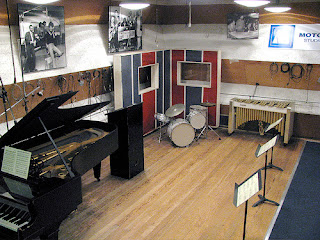My spouse and I visited the Motown Museum on a Sunday
morning in early July 2017. The museum is open Tuesdays through Saturdays from
10:00 am to 6:00 pm (with extended hours on Saturday evenings until 8:00 pm).
Lucky for us, in the summer months, the museum is also open on Sundays from
10:00 am to 6:00 pm. Street parking is available. Admission costs $15 for
adults, with discounts for seniors and children. Tours are managed (not
self-guided) and are capacity-controlled. (Every 30 minutes a tour group of
about 25 people departs.) Although we saw a few people purchase tickets onsite,
we bought them online ahead of time so that the time slot we wanted would not
be sold out. A small gift shop and restrooms are available, and parts (but not
all) of the tour are handicap-accessible. Note that if you buy tickets for the
first tour of the day, you must wait outside on the front sidewalk, lawn, or
porch until a tour guide opens the doors at precisely 10:00 am. Also, even if
you have printed confirmation from your online purchase, you will need to line
up with all other customers [even those without tickets] in order to check in.
Our guide/narrator was excellent,
exhibiting a combination of humor, friendliness, and talent. (Gratuities are
accepted, although not in any way solicited.) He led us on an hour-long tour
through “Hitsville USA”, the nickname given to Motown’s first headquarters on
West Grand Boulevard (nicknamed “Berry Gordy Jr. Boulevard”). Berry Gordy
purchased the first house (a former photography studio) in 1959, and as his record
business grew, he bought seven neighboring houses to create his empire. In
1959, Berry started the Tamla record label with just $800, and it grew into a
multi-million dollar empire that produced music legends like Stevie Wonder, the
Jackson Five, Marvin Gaye, the Temptations, and the Supremes. In the early
1970s, the Motown label moved to Los Angeles, and Berry Gordy’s sister began her
plans to turn the historic houses into the Motown Museum, which opened in 1985.
After purchasing tickets (or showing
our electronic confirmation), we were marshalled into an area behind the gift
shop that showed photographs on the walls along with a sort of 3-D
representation of the houses that comprised the Detroit Motown empire in its
heyday. Then, we filed into a small observation room (overlooking recording
Studio A) and occupied rows of chairs while we viewed an interesting 20 minute
video about the genre. Next, we climbed the stairs to the second floor (an
elevator is also available), where we stood in a room filled with framed photos
and a few pieces of furniture memorabilia. This room also featured a sort of
echo chamber, with a whole cut into the ceiling to create a kind of tunnel
under which singers practiced because of the excellent acoustics.
The first
room contained photos of Maxine Powell (who taught the musicians about
grooming, dressing, and social graces) and Cholly Atkins (who taught them
choreography). In an adjacent room, we were allowed to roam a bit to see
additional photos and glass-enclosed cases filled with memorabilia (including
Jackson Five costumes and Michael Jackson’s white glove and black hat). We
particularly enjoyed viewing the album art covering the hallway that lead to
the neighboring house.
As other reviewers have expressed, it would be nice to
be allowed to view these two upstairs rooms for a longer time because they
truly are filled with interesting items, but after about 10 minutes on our own,
we had to move on. Note that no photography is permitted inside the house. When
our time was up, our tour guide asked us to proceed across the connector to the
second floor of the neighboring house, through a replica of Gordy family
apartment (combination living/dining room, with a peek into the kitchen and
bedroom), and then down a flight of stairs to view the street level administrative
offices, control room, and tape library. (Be sure to look for the antique candy
vending machine and cigarette machine as you hear stories about how the offices
were open 22 hours per day!) Toward the back of the second house is the
original attached garage that houses recording Studio A, where you can see an
1887 Steinway grand piano (restored courtesy of Paul McCartney) and other
original instruments and recording devices like microphones, sound buffers, and
music stands. We even got to sing a bit of the Temptations hit “My Girl”
(written by Smokey Robinson) as the culmination to our tour!
We enjoyed our visit to the Motown Museum – it was humbling to stand in a
place where such music history was made!









No comments:
Post a Comment